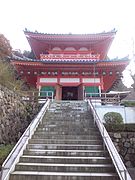Tsubosaka-dera
The Tsubosaka-dera ( Japanese 壺 阪 寺 ), formally Minamihokke-ji ( 南 法華寺 ), with the mountain name Tsubosaka-san ( 壺 阪 山 ) is a temple of a branch of the Shingon direction of Buddhism. The temple is located in Takatori in Takaichi County ( Nara Prefecture ), Japan, below Tsubosaka Mountain. It is the 6th temple on the Saigoku pilgrimage route in traditional counting .
history
According to tradition, priest Benki ( 弁 基 上人 ) came in the year Daihō 3 (703) on his pilgrimage through the area, found rock crystals on Mount Tsubosaka, which he loved, and carved a Kannon figure out of gratitude . This started the development of the site into this temple.
The attachment
You enter the temple complex at the foot of the hill through the temple gate ( 山門 Sanmon ; 1 in the plan) from 1212, which is called Niō-Tor ( 仁王 門 Niō-mon ), i.e. through a gate with the two temple guards to the right and left of the passage is executed. Then you climb a long staircase to the inner complex, which was built on a rocky plateau. There is a three-story pagoda ( 三重 塔 Sanjū-no-tō ; 4) and the “worship hall” ( 礼堂 Reidō ; 2), to which the main hall ( 八角 堂 Hakkaku-dō ; 3), here octagonal, adjoins. The worship hall and pagoda are registered as an Important Cultural Property of Japan .
Slightly below is an old-style treasure pagoda ( 多 宝塔 Tahōtō ; 5) from 2003 and the "Hall of the View of Mercy" ( 慈 眼 堂 Jigen-dō ; 8).
There is also the “Amida Hall” ( 阿 弥陀 堂 Amida-dō ), the “Benten Pavilion” ( 弁 天堂 Benten-dō ), the “Gongen Pavilion” ( 権 現 堂 Gongen-dō ), the Bell tower ( 鐘楼 Shōrō ), a meeting hall ( 納 礼堂 Nōrei-dō ) and other buildings.
In the Indian-designed treasure house ( 天竺 渡 来 大石 堂 Tenjiku-torai Ōishi-dō ; 6) are u. a. the following stone figures can be seen:
- a large Kannon from India ( 天竺 渡 来 大 観 音 石像 Tenjiku-torai Dai-Kannon sekizō )
- a large dying Buddha from India ( 天竺 渡 来 大 涅槃 石像 Tenjiku-torai Dai-Nehan sekizō )
- a great Shaka Nyorai from India ( 天竺 渡 来 大 釈 迦 如 来 石像 Tenjiku-torai Dai-Sahaka Nyorai sekizō )
Nearby is the Shaka Nyorai as an enlarged copy (7) from 2007. It is 10 m high and sits on a base 5 m high.
A large stone Kannon figure (A), which was erected in 1983, stands on the hill separated by Prefecture Street 119. With a height of 20 m and a weight of 1200 tons, it is an enlarged copy of the Kannon in the Indian treasury. At the bottom of a square you can see the dying Buddha (9), 8 m long, also an enlarged copy, made in stone, this one from 1999. Below this temple area there is a newly created cemetery (F).
Temple treasures
The temple treasures include the objects awarded as an Important Cultural Property of Japan, a brick plate with a phoenix pattern ( 鳳凰 文 磚 Hōō monsen ) from the early Nara period and a colored mandala on silk ( 絹本 著色 一字 金輪 曼荼羅 図 Kinmoku chakushoku ichiji kinrin mandara -zu ) with the dimensions 107 × 83.8 cm from the Kamakura period .
photos
Remarks
- ↑ 天竺 Tenjiku is the old word for India.
literature
- Nara-ken kotogakko-kyoka token kenkyu-kyokai rekishi bukai (Ed.): Tsubosaka-dera . In: Nara-ken no rekishi sampo (ge). Yamakawa Shuppan, 2010. ISBN 978-4-634-24829-8 . Pp. 73, 74.
Web links
Coordinates: 34 ° 25 ′ 35.6 ″ N , 135 ° 48 ′ 37 ″ E









